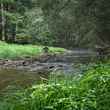I watch the season's first snowfall roll over Rocky Mountain National Park as I make my way down U.S. 36 into Estes Park. I’m in awe of the white tundra that sweeps across the jagged mountain peaks and clashes with bright yellow aspens still covering the landscape. Between breaks in the fast-moving clouds, intermittent bursts of morning sunshine illuminate the face of Longs Peak and The Mummy Range. This swift cold front feels abrupt given I had just returned from a balmy fall backpacking trip over the weekend with friends in the Wild Basin Area. While the sudden chill isn’t unfamiliar to me, the sight is surreal compared to the views I’m used to back home in Chicago.
The closer I get to the park, the stronger my excitement swells. While I’m anxious to send my first cast into the wild streams that I’ve traveled so far to fish, I’m also itching to meet my guide, Taylor Hames of Sasquatch Fly Fishing.
Truth be told, though, even more than catching fish, I’m eager to get out on the water with her.
A few weeks back I had reached out to book a half-day trip with Sasquatch, an outfitter that guides exclusively for the YMCA of the Rockies. This long-time institution in Estes Park has served as a base camp for families visiting Rocky Mountain National Park since the early 1900s. The sprawling 860-acre property borders the national park, and today is the largest YMCA camp and conference center in the world — drawing more than 220,000 people to their location every year.
But why do so many flock to the YMCA of the Rockies to recreate? Their unwavering focus on affordability and accessibility, including fly fishing.
I heard the YMCA’s guided trips were much more affordable than your average fly shop. For a one-on-one outing, Sasquatch charges $175 — significantly less than the average price of equivalent trips around the country. I also got word Sasquatch has a strong roster of female guides. It’s not common that I call up a fly shop to request a female guide and get the response I’m hoping for: “Yes, we can set you up for a day on the water with [insert female guide’s name here].” More often than not, my request is greeted with an immediate “We don’t have any female guides.” or “Our female guide is already booked but we have plenty of male guides we can send you out with.” When booking this trip, there was no hesitation.
I pull up to the Boone Family Mountain Center around 7:30 a.m. and spot a lone car in the far corner of the parking lot. A bundled-up guide meticulously loads fly fishing gear into the back of her silver Ford Escape and I walk over with the assumption it’s Taylor. I was right. We shake hands, she fits me in waders, and then lays out the plan for our day on the water: We’ll start at a nearby stocked private pond to get warmed up before returning to the YMCA of the Rockies to fish on-site at Glacier Creek.
We hit the road and I take advantage of the short drive to ask Taylor about her guiding experience. Not how long she’s been guiding, or how many fish she’s netted this summer, but what it’s like for her to guide in such a coveted part of the country for fishing — as a female guide. From what I’ve heard, lady guides are typically outnumbered by male counterparts and have, more often than not, dealt with some challenging situations as a result.

Turns out Taylor is one of six female guides on a 15-person guide team at Sasquatch — a 40% female-to-male ratio. That’s the highest number of female guides I’ve yet to encounter at a fly fishing outfit. She continues on, reminiscing about how strong of a bond she’s built with her peers — both men and women — over the last two summers and her affinity for the welcoming environment Sasquatch fosters for guides and clients alike. Hames says their group’s strong bond is a result of a fly shop leader that has prioritized diversifying their guide pool and uplifting everyone on the team.
“Our founder, Joe, like a lot of the guides on our team, grew up not having everything he wanted,” Hames explains as we make our way down winding mountain roads. “That meant the ability, or actually lack of ability, to go fly fishing regularly since there’s such a high barrier to participating in the sport — like how much it costs. He’s really a good guy.”
Hames shares how Sasquatch guides at an impressively affordable rate and sells nearly all of their gear at cost in their shop at the YMCA — a game-changer for beginners and first-timers who go out on the water with Sasquatch and immediately fall in love with the sport.
“You know you killed a trip when at the end of the day the client asks, ‘So, do you guys sell fly rods?’ and we’re able to send them off with a kit at a fair price,” Hames adds.

We eventually pulled up to our fishing spot of the day. To be honest, I wasn’t all that jazzed about fishing a private pond to start our trip. Even as a newer angler, something about hooking stocked trout seems unnatural. Yet despite my early reservations, I step out of the car to see we’ve arrived at one of the most scenic spots I’ve ever fished. It’s no wonder Taylor wanted to take me here.
With Longs Peak towering in the foreground and The Twin Sisters mountain range behind us, we’re surrounded on all sides by natural beauty. Taylor ties on a single Griffiths Gnat to my rig in the parking lot before leading us down a gravel walking path to the pond. We walk up as a gentle breeze sends a slight ripple across the water. I cast and disrupt the near picture-perfect reflection of Longs Peak with my fly line. Fish rise to the surface across the pond but hesitate to bite. I wait patiently for some action. A few more casts are all it takes for us to realize these fish may be too picky for our liking. Instead, we opt to drive down the road to a larger pond where Taylor’s confident we can land a fish or two.

We make our way down the beach, working the east end of the pond. I start to realize how nice it is to have a large body of water and minimal obstructions to practice finessing my cast. The wide open space surrounding the pond affords me the freedom to see how far I can throw the line. Pond fishing is starting to grow on me.
I still manage to tangle my line in the tall grasses behind me after dropping the tip of my rod on my back cast. The attention-grabbing views of the mountains are quite the distraction too. Without luck on the dry fly we switch over to a streamer rig — a Balanced Leech — and shortly after casting the new setup, my line jerks with a swift tug. I tighten up and set my hook into a small but mighty rainbow trout. Taylor coaches me through the fickle game of keeping appropriate tension on the line as I reel him in. The fish and I tussle for a minute before he bows out of the fight. Taylor nets him and we celebrate our first victory of the day with a high five and ear-to-ear smiles on our faces. This sort of cheering and comradery comes easy with a guide like Taylor.
Only a few casts later, a feisty brook trout takes and inhales my fly. I land my second fish of the day. We decide it’s time to move on to more wild water with two fish on the books. We load up the car and head back to the YMCA of the Rockies to fish Glacier Creek, a meandering and rock-filled stream that borders the edge of the YMCA property and Rocky Mountain National Park.
Between brief lessons in knot tying and on-the-fly coaching to land my first two fish, it’s clear Taylor takes an attentive approach to guiding. On our trip back, I ask Taylor for her thoughts about the common attributes of female guides — not only on her team but others she’s fished with too.
“I’ve noticed that female guides seem to be a lot more observant of their clients,” she shares. “For example, when Ali, a lead guide on our team, teaches a casting class, she does a lot more watching and correcting than some male guides typically do. I think female guides are often more conscious of clients’ needs and have a natural maternal instinct on the water. We “read the room” and, in general, take a more caring approach to the way we guide.”
As a client of both male and female guides, I’ve come across this in my own experience as well. I often feel more open and comfortable asking questions of female guides than male guides as my asks are met with anecdotes and conversation rather than a bare-boned response. Coaching and caring build confidence on the water. It fuels tenacity to keep trying, even in the face of adversity. In fact, recent data from the Recreational Boating & Fishing Foundation found that almost half of active female anglers say that fishing teaches them patience and helps to develop their confidence. I’m proof.

We arrive back at the YMCA of the Rockies in Estes Park and head down a gravel drive to the back side of the Boone Family Mountain Center. A well-manicured path leads us alongside the river to several ideal spots to wade. Taylor takes time to flip over rocks. She’s in search of signs of what’s living below the surface — rather, what the fish are eating. We spot a small stonefly crawling on the underside of the rock. This is a good sign.
Taylor then offers a quick lesson on reading the water. There’s always something new to learn and it never ceases to amaze me that there are fish within these tiny pools. Taylor reassures me we are in the company of brown, brook, cutthroat, and rainbow trout on this stretch of Glacier Creek. Tucked away in the woods, surrounded by dense forest that leads into the wilderness of Rocky Mountain National Park, I’m soaking in what feels like our own little slice of fly fishing paradise. I cast my dry dropper rig run after run for over an hour as I make my way down the edge of the creek. Even without any action yet, this is bliss.
Nearing the end of our day together, a large, mossy rock with a sizable pool catches my eye. I cast my line on the inner, slow-moving edge of the current. My Chubby Chernobyl drifts and starts to pick up speed. Surely between the Chubby, the Rainbow Warrior below, and this spot-on drift, I’ll land something. My fly heads toward a small pile of rocks at the end of the run. Just as I’m about to lift and recast back upstream before hitting the rifle, I feel a tug on the end of my line. I’ve got one.

It’s not a long fight to pull in the small brown. Yet, despite its size, it’s a big win: my first ever “Grand Slam” on the water. One rainbow trout, one brook trout, one brown trout — all in one day. It’s moments like these I feel myself becoming a stronger, more independent angler. I picked this spot, threw this cast, and landed this fish by myself. But, actually, I wasn’t alone.
“That’s a good-looking brown right there,” Hames says with a grin. “And your first Grand Slam!”
I grin right back. She’s right.

































Comments